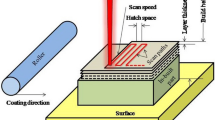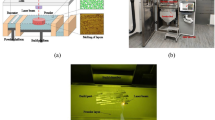Abstract
This document examines the manufacturing accuracy of AISI 316L corrosion steel material with 3D printing across geometric tolerances with a focus on angle formation with and without support. The measured data were compared with a CAD model, which also served as an input element to a 3D printer. The experiment points out the possibilities of creating angles without support up to certain degrees and their deviation from the ideal body.
Access this chapter
Tax calculation will be finalised at checkout
Purchases are for personal use only
Similar content being viewed by others
References
Frazier, W.E.: Metal additive manufacturing: a review. J. Mater. Eng. Perform 23, 1917–1928 (2014)
Hlinka, J., et al.: Complex corrosion properties of aisi 316L steel prepared by 3D printing technology for possible implant applications. Materials 13(7) (2020). https://doi.org/10.3390/ma13071527
Gao, W., et al.: The status, challenges, and future of additive manufacturing in engineering. Comput. Aided Des. 69, 65–89 (2015)
Haleem, A., Javaid, M.: 3D printed medical parts with different materials using additive manufacturing. Clin. Epidemiol. Glob. Health (2019)
Kong, D., et al.: Heat treatment effect on the microstructure and corrosion behavior of 316L stainless steel fabricated by selective laser melting for proton exchange membrane fuel cells. Electrochim. Acta 276, 293–303 (2018)
Lichovník, J., Mizera, O., Sadílek, M., Čepová, L., Zelinka, J., Čep, R.: Influence of tumbling bodies on surface roughness and geometric deviations by additive SLS technology. Manuf. Technol. 20(3), 342–346 (2020). https://doi.org/10.21062/mft.2020.050
Kořínek, M., et al.: Monotonic tension-torsion experiments and FE modeling on notched specimens produced by SLM technology from ss316L. Materials 14(1), 1–15 (2021). https://doi.org/10.3390/ma14010033
Mesicek, J., et al.: Abrasive surface finishing on SLM 316L parts fabricated with recycled powder. Appl. Sci. (Switzerland) 11(6) (2021). https://doi.org/10.3390/app11062869
Strnadel, F.: Methods of 3D CMM measurement of selected components of additive manufacturing. Bachelor thesis, 65 (2021)
ČSN EN ISO 1101 (014120): Geometric Product Specifications (GPS): Geometrically tolerated: Tolerances on shape, orientation, location and throw. Institute for Technical Standardization, Metrology and Testing, Prague (2017)
ČSN ISO 2768–2 (014406) General tolerances: Non-prescribed geometric tolerances. Institute for Technical Standardization, Metrology and Testing, 12 (1994)
Additivní technology - Method Rapid Prototiping. http://ust.fme.vutbr.cz/obrabeni/poklady/sto_bak/cv_STV_04_Aditivni_technologie_metody_Rapid_Prototyping.pdf. Brno (cit. 17 June 2021)
Monkova, K., Monka, P.: Qualitative parameters of complex part produced by additive approach. Paper presented at the 2017 8th International Conference on Mechanical and Aerospace Engineering, ICMAE 2017, pp. 691–694 (2017). https://doi.org/10.1109/ICMAE.2017.8038732
Allen, S., Dutta, D.: About the calculation of the orientation of the part using the supporting structure in layered production. In: Solid Freeform Fabrication Symposium, pp. 59–269 (1994)
Component shape inspection. Ostrava [cit. 1 Sept 2021]. http://www.iae.fme.vutbr.cz/userfiles/ramik/files/Studium/Poklady%20ke%20studiu/3D%20skenov%C3%A1n%C3%AD/E-learning-Inspekce%20tvaru%20soucasti.pdf
Alignment used for quality control (QC). Brno: 3dSCAN (2020) [cit. 14 June 2021]. https://www.3d-skenovani.cz/pouzivane-zarovnani-pri-kontrole-kvality-qc/
https://www.wenzel-group.com/en/products/wenzel-shapetracer-laser-scanner/
https://support.hexagonmi.com/s/article/Understanding-Best-Fit-Alignments-1527312042816
Massod, S.H., Rattanawong, W., Lovenitti, P.: A generic algorithm for a best part orientation system for complex parts in rapid prototyping 139(1–3), 110–116 (2003). https://doi.org/10.1016/S0924-0136(03)00190-0
Mishra, A.K., Thirumavalavan, S.: A study of part orientation in rapid prototyping (2014)
Čapková, V., Zetková, I.: RP technology used for the production of metal part. Mater. Sci. Forum 818, 280–283 (2015)
Čapková, V.: Restrictive parameters of 3D printing (2015)
ČSN EN ISO 17 296-2 (011810): Additive manufacturing - Basic principles - Part 2: Overview of process and raw material categories (2017)
Čepova, L., Kovacikova, A., Cep, R., Klaput, P., Mizera, O.: Measurement system analyses – gauge repeatability and reproducibility methods. Measur. Sci. Rev. 18(1), 20–27 (2018). https://doi.org/10.1515/msr-2018-0004
Funding
This paper was completed in association with the project Innovative and additive manufacturing technology—new technological solutions for 3D printing of metals and composite materials, reg. no. CZ.02.1.01/0.0/0.0/17_049/0008407 financed by Structural Funds of the European Union and project.
This paper article has been elaborated in the framework of the grant programme “Support for Science and Research in the Moravia-Silesia Region 2018” (RRC/10/2018), financed from the budget of the Moravian-Silesian Region.
Author information
Authors and Affiliations
Corresponding author
Editor information
Editors and Affiliations
Rights and permissions
Copyright information
© 2022 The Author(s), under exclusive license to Springer Nature Switzerland AG
About this paper
Cite this paper
Mizera, O., Hajnys, J., Cepova, L., Zelinka, J., Mesicek, J. (2022). Laser Measurement by Angle Accuracy Method in Additive Technology SLM 316L. In: Diering, M., Wieczorowski, M., Harugade, M., Pereira, A. (eds) Advances in Manufacturing III. MANUFACTURING 2022. Lecture Notes in Mechanical Engineering. Springer, Cham. https://doi.org/10.1007/978-3-031-03925-6_8
Download citation
DOI: https://doi.org/10.1007/978-3-031-03925-6_8
Published:
Publisher Name: Springer, Cham
Print ISBN: 978-3-031-03924-9
Online ISBN: 978-3-031-03925-6
eBook Packages: EngineeringEngineering (R0)




